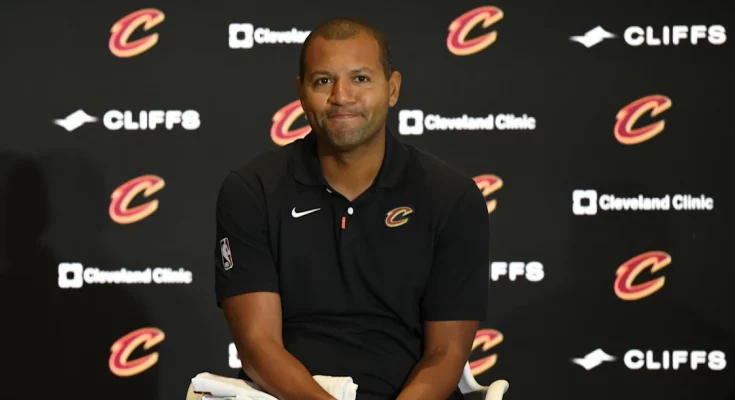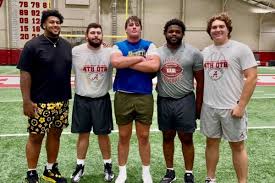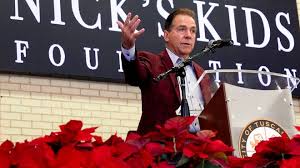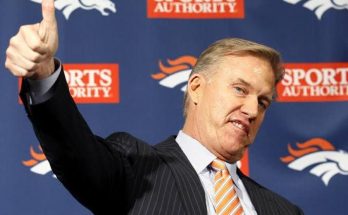The Cleveland Cavaliers front office has found itself in the national spotlight once again, but this time it is not because of a blockbuster trade or a shocking roster shakeup. Instead, the organization is being celebrated for the meticulous and forward-thinking approach that has shaped its current roster and long-term vision. A recent ranking of NBA front offices placed the Cavaliers among the most respected in the league, with analysts and insiders praising their blend of patient team-building, strategic drafting, and calculated trades. This acknowledgment serves as a testament to the hard work of general manager Mike Gansey, president of basketball operations Koby Altman, and the entire management team who have transformed the Cavaliers from a rebuilding franchise into a team that now looks poised to compete for deep playoff runs in the coming years.
The Cavaliers’ transformation over the past several seasons has been anything but accidental. When LeBron James departed for Los Angeles in 2018, many experts believed Cleveland would spiral into a prolonged era of mediocrity. For a franchise so closely tied to the success of a once-in-a-generation player, the path forward seemed unclear. Yet, rather than chasing short-term fixes or burning assets for quick success, the front office took a deliberate and disciplined approach. They opted to prioritize player development, smart drafting, and carefully timed trades to assemble a roster that not only competes but also possesses significant upside for the future. This strategy, while slow and at times criticized, has paid dividends and is now earning the respect of executives across the NBA.
The backbone of the Cavaliers’ success can be traced to their ability to identify young talent in the draft. Selecting Darius Garland with the fifth overall pick in 2019 was seen as a gamble at the time, as Garland had played just five college games due to injury. But the Cavaliers trusted his talent and vision as a lead guard, and their belief has been validated as Garland blossomed into an All-Star playmaker. The following year, they doubled down on their draft strategy by selecting Isaac Okoro, a defensive-minded wing whose energy and versatility have become invaluable for the team. Perhaps the front office’s crowning achievement, however, came in 2021 when they secured Evan Mobley with the third overall pick. Mobley’s defensive prowess and ability to impact the game on both ends of the floor have drawn comparisons to some of the league’s elite big men, and he is widely seen as a cornerstone of Cleveland’s future.
The Cavaliers’ ability to blend youth with experienced talent has also been a key factor in their rise. While developing players like Garland and Mobley, the front office made the bold move to trade for All-Star guard Donovan Mitchell in 2022. That trade signaled a shift from a rebuilding mindset to a win-now approach. Mitchell’s explosive scoring ability, combined with Garland’s playmaking, created one of the most dynamic backcourts in the NBA. Critics initially questioned whether the Cavaliers had given up too much to acquire Mitchell, but the early returns have been overwhelmingly positive. Not only has Mitchell delivered elite production, but his presence has also accelerated the growth of the younger players around him.
In addition to drafting and trades, the Cavaliers’ front office has displayed remarkable patience in free agency and cap management. Rather than overspending on short-term contracts or chasing marquee names that don’t fit their system, they have targeted role players who complement their stars. Players like Caris LeVert, Jarrett Allen, and Max Strus have been key acquisitions that add depth and versatility to the roster. Jarrett Allen, in particular, has been a revelation since arriving via trade from the Brooklyn Nets, anchoring the defense with his shot-blocking and rim protection while forming a formidable frontcourt duo with Mobley. The Cavaliers’ front office has shown that success isn’t always about chasing superstars but about building a cohesive unit where each piece fits seamlessly.
The recognition the Cavaliers are receiving is also a reflection of their ability to establish a strong organizational culture. Unlike many franchises that flounder in the post-superstar era, Cleveland has created an environment where players are encouraged to grow and thrive. This culture is a credit to the collaboration between the front office and the coaching staff. Head coach J.B. Bickerstaff has worked hand-in-hand with management to develop a style of play that maximizes the strengths of the roster. The defensive identity the Cavaliers have embraced is not only a result of having talented defenders like Mobley and Allen but also the vision of a front office that values two-way basketball.
One of the more impressive aspects of Cleveland’s approach has been their ability to navigate challenges without panicking. When injuries or underperformance struck, the front office resisted the urge to make rash decisions. Instead, they trusted their core players and the long-term plan they had put in place. This stability has allowed the Cavaliers to build continuity, something that is often overlooked but critical to sustained success in the NBA. Teams that constantly shuffle their roster rarely develop the chemistry necessary to win at a high level, but Cleveland’s leadership has recognized the value of consistency.
The recent ranking that lauds the Cavaliers’ front office is not just about their past moves but also about the position they have put themselves in moving forward. With a young core of Garland, Mobley, and Allen, supplemented by a star like Mitchell, the Cavaliers have the foundation of a team that can compete for years to come. They also have the flexibility to continue improving, whether through trades, draft picks, or free agency. The front office’s ability to balance present success with future potential is a major reason why they are now viewed as one of the league’s best-run organizations.
This recognition is particularly meaningful when viewed in the context of the Cavaliers’ history. For years, the franchise’s fortunes were closely tied to LeBron James, and while his era brought a championship and several Finals appearances, it also left the impression that Cleveland could not thrive without him. By building a competitive team post-LeBron, the current front office has dispelled that notion. They have proven that with the right vision, leadership, and patience, a small-market team can build a contender even in the modern NBA landscape.
Fans have noticed this shift as well. The energy at Rocket Mortgage FieldHouse has been electric in recent seasons, with fans rallying behind a young and exciting team that they know is built for the long haul. Unlike the uncertainty that followed LeBron’s departure, there is now a sense of optimism and stability. This newfound confidence among the fanbase can be attributed directly to the work of Altman, Gansey, and the rest of the front office staff.
Of course, with praise comes expectation. The Cavaliers are no longer viewed as a rebuilding project but as a legitimate playoff contender. The challenge for the front office will be to continue making smart decisions that push the team closer to championship contention. There is still work to be done, particularly in terms of improving offensive efficiency and adding depth on the wings, but the Cavaliers’ leadership has shown they are more than capable of meeting these challenges. If they continue on their current trajectory, it is not far-fetched to imagine Cleveland becoming a perennial powerhouse in the Eastern Conference.
The praise being heaped on the Cavaliers’ front office serves as a reminder that success in the NBA is rarely instantaneous. It is the result of years of planning, scouting, and developing a clear organizational philosophy. Cleveland’s rise from the ashes of a post-LeBron rebuild to one of the most promising teams in the league is a case study in how to rebuild the right way. Rather than relying on luck or chasing quick fixes, they invested in their own process and stayed the course. The result is a team that is not only competitive now but also built to last.
As the Cavaliers continue their journey, the front office’s reputation will only grow if they can turn potential into postseason success. Winning playoff series, and eventually competing for championships, will be the ultimate validation of their strategy. But for now, earning recognition as one of the top front offices in the NBA is a well-deserved accolade. It is a moment that underscores how far the franchise has come and how bright the future appears. The Cavaliers’ front office has not just built a team—they have built hope, and that is something that resonates deeply in Cleveland, a city that knows both the agony and the ecstasy of professional sports.



